Decoding the Civil War : End
It is with sorrow that I announce the shuttering of Decoding the Civil War. As many are aware, Decoding the Civil War has been on pause since January 2018. We first attempted to build a new crowdsourcing interface, called Phase 2, building on the hard-earned transcripts from you, our faithful volunteers. This interface asked that volunteers work with individual telegrams, identifying specific metadata such as the sender, recipient, date sent, time received, etc.
However, this tagging of individual telegrams ran into significant technical difficulties. Therefore, in respect to our volunteers, and after time and effort had been spent trying to fix the technical issues, it was decided this past June follow a new path. We will instead extract through text mining the data required. We are optimistic about the results as we are using the clean transcriptions you valiantly produced in Phase 1.
All our volunteers have done great work, and that work will continue to help and inform researchers for some time to come. You can see your hard work on the Huntington Digital Library in the Thomas T. Eckert Papers at: https://hdl.huntington.org/digital/collection/p16003coll11.
I am very happy to have known and worked with you, our volunteers. Your fervor, your determination, your industry, made Decoding the Civil War a great success.
One last time, three cheers for our volunteers!

Huzzah! Huzzah! Huzzah!
Sincerely,
Mario Einaudi
Decoding the Civil War Lead
New Year’s Resolution
It is that time of year again! Here is my New Year’s resolution: To make sure that the next meeting of the Symposium on Cryptological History features a panel on the Civil War codes.
The American Historical Association’s Zoë Jackson reports on this year meeting in the latest issue of the Perspectives:
“the two-day symposium reflects a greater truth about intelligence work: it is deeply indebted to the work of the code breakers who came before, and that cryptologic history should inform intelligence work being done today.”
It is about time that our good friends the cipher men of the United States Military Telegraph get the recognition they so obviously deserve!
Happy New Year!

Winslow Homer. Seeing the Old Year Out. Harper’s Weekly, Jan. 5, 1861
What If?
Alternate history is fun. It is very satisfying to imagine what would have happened if Alexander the Great had not died young, or Napoleon had succeeded in cobbling together a world empire. It is no wonder that alternative history has evolved into a rich genre that allows its practitioners to indulge in historical fantasies or offer dire warnings.
Since the early 1900, the American Civil War has been occupying a sizeable chunk of this literary real estate, producing its own genre of Civil War alternate history (CWAH) –see Renee de Groot’s wonderful article Divided We Stand: “Confederate” and Civil War Alternate Histories.
This CWAH narrative admittedly is a bit repetitive as it tends to hinge on the Confederacy winning the war. This “what-if-ism” occasionally takes somewhat amusing forms: in his Man of War: My Adventures in the World of Historical Reenactment (Penguin, 2013), journalist Charlie Schroeder recounts his stint at the two-day annual reenactment the Brooksville Raid: on Saturday the Union troops win, but on Sunday, it is the Confederates turn, because, as one reenactor told journalist, the event’s coordinator, a Baptist minister, “wants the Confederates to win on the Lord’s day.”
CWAH traditionally entailed a rosy picture of the flourishing independent South inhabited by benevolent planters, graceful and tenderhearted females, and happy slaves. This fantasy was not the sole domain of the exponents of the “Lost Cause.” In his (exceedingly boring) novel Hallie Marshall: A True Daughter of the South (1900), Frank Purdy Williams, a progressive reformer, held up this imaginary “Southland” to contrast with the horrible labor conditions in the Gilded Age America. Ernest Howard Crosby, wrote “If the South Had Been Allowed to Go,” (1903) to speculate that if it had not been for the imperialist North, slavery would collapse in the South organically, without “the evils which we have entailed upon ourselves by the manner of its abolition.” Winston Churchill offered that if the Confederacy had triumphed, it would forge a “new fundamental relationship between master and servant” instead of the effort to “graft white democratic institutions upon the simple, docile, gifted African race belonging to a much earlier chapter in human history.”

At the turn of the last century, the picture of a Confederate victory took a darker turn. Harry Turtledove’s The Guns of the South (1992) has a supply of AK-47 delivered to the struggling Confederacy by a time-traveling group of South African racists. It became even more jarring as historians dispelled the once common assumptions that that the Union victory was preordained or that slavery would have ended on its own. CWAH embraced and rather realistic image of a United States resting on slavery and white supremacy, most vividly and chillingly portrayed by Ken Willmott’s in his mockumentary CSA: The Confederate State of America (2004) or in Ben Winters Underground Airlines (2016).
CWAH tends to think grand, largely in terms of great battles and great men. But what if we think on a less grandiose scale? For example, what if Anson Stager’s parents had decided to move South and the inventor of the USMT code had been born in Virginia rather than New York?
On one hand, he might not have even made it in telegraphy. He would not have been apprenticed to Henry O’Reilly at the Rochester Daily Advertiser, and quite possibly had no one to introduce him to telegraph business. Stager certainly would have never made it as the first general superintendent of Western Union.

- In 1845, Henry O’Reilly (1806-1886), an Irish immigrant and a Rochester, N.Y., entrepreneur, contracted with Samuel F.B. Morse and Amos Kendall in the planned construction of telegraph wires from eastern Pennsylvania to the Great Lakes.
On the other hand, had Stager been born in Virginia, entered telegraphy, and shown the same promise, he could have risen to the top of the American Telegraph Company which had lines in the North and South. (Western Union lines lay entirely within the Union). He could have associated with Dr. William Sylvanus Morris (1823-1893) of Lynchburg, Va., and, like him, become a Southern director for the company. Stager could have been present at the emergency meeting of the company’s executives on May 12, 1860 which split the American Telegraph Company into Southern and Northern branches. And, as a superintendent or even president of the Southern Telegraph Company, he would have taken an oath of loyalty to the Confederacy.
And, of course, it could have been the governor of Virginia John Letcher rather than Ohio’s William Dennison to ask Stager to develop the codes for the Confederate army. In the fall of 1861, Stager could have used his organizational talents to build up the Confederate Military Telegraph that would report directly to Jefferson Davis and his Secretary of War Judah P. Benjamin.
With the Confederate command in possession of superior telegraph communications and unbreakable ciphers, its chances of winning would have increased exponentially. It would certainly have minimized a possibility of Union soldiers coming across battle plans wrapped around some cigars, as it happened with Robert E. Lee’s orders to General D.H. Hill before the battle of Antietam. More importantly, it would have afforded unprecedented level of battlefield and logistical communications not to mention infinite possibilities to mess with the increasingly bitter partisan divisions in the North.
Could a simple accident of birth have changed the course of history? Is it impossible to imagine that should Stager’s life have taken a different turn, alternative historians would now be speculating what would happen if the North had won the war? Is it inconceivable that we could be now living in a world where Willmott’s CSA was an honest to goodness documentary?

Olga Tsapina, Norris Foundation Curator of American History, Huntington Library.
Phase 1 Transcription Complete! Huzzah! Huzzah! Huzzah!

On June 21, 2016 we embarked on Decoding the Civil War, an ambitious project to transcribe 12,921 handwritten pages from 35 ledgers. These ledgers were from the archive of Thomas T. Eckert, head of the Washington office of the United States Military Telegraph, Assistant Quartermaster of U.S. Army, and Assistant Superintendent of the U.S. Military Telegraph.

- Thomas T. Eckert
The 35 ledgers record the telegrams sent and received by the War Department during the American Civil War. About one-third of the recorded messages in the ledgers were written in code, and another third may have never been published in the The War of the Rebellion: A Compilation of the Official Records of the Union and Confederate Armies (often simply abbreviated to OR), and there are more than 100 communiques from Lincoln himself.
As of this morning, November 15, 2017, we can announce that all the ledgers have been transcribed by our Volunteer Corps! All the difficult work of parsing sentences, figuring out 19th Century hand and spelling, and even dealing with difficult to read, smeared, pages has been completed in under 17 months. An incredible achievement. It would have taken 2 staff members working nearly full time 3 to 4 years to reach this goal!
We have begun to publish those ledgers on the Huntington Digital Library; 16 are already available for researchers. As we work though the huge amount of data provided by our Volunteer Corps, the remaining volumes will be published. We are excited to provide this new trove of American Civil War material to the Public, Researchers, and Students. The work completed has already been used to create educational materials that will be published shortly.
We began this project hoping to be finished in six months to a year. We learned quickly that it would take longer, that the task was full of challenges, and that tools needed to be built to overcome some of those challenges. Through it all our loyal volunteers stayed with Decoding the Civil War. As we move forward with the next phase of our project we will call again on those volunteers to help.
Right now, those volunteers can rest. All who have worked on Decoding the Civil War deserve thanks.
Thank You.

Strike up the Band! A lively polka is in order!
Thank you also to the National Historical Publications and Records Commission (NHPRC), which funded a two year grant for this project and to our institutions who have provided support throughout: The Huntington Library, Art Collections, and Botanical Gardens; North Carolina State University; and Zooniverse with its spectacular team at the University of Minnesota. Finally, a thank you to Daniel W. Stowell, whose advice, support and enthusiasm has been fundamental since the beginning.
Bonkers

“Bonkers” message. EC 19. Ciphers Sent. 1864, Jan. 27 — 1864, Dec. 2. P. 293.
I’ve often felt that that the vocabulary of archival description could benefit from some content designators. When it comes to ciphered telegraphic messages, the term “bonkers,” as applied to the telegram above, seems very apt.
The USMT cipher men indeed appear to have been on a mission not dissimilar to the staff of the “Confuse-a-Cat” outfit from the Monty Python sketch.
The ciphers were constantly changed, modified, updated, and otherwise fiddled with. The first version of the cipher, developed by Anson Stager for Governor of Ohio in April 1861, was so short that it fit on the back of a business card. The last iteration to be used during the war, cipher No. 4, contained some 1500 arbitraries. The ciphers were numbered out of conventional sequence: the ciphers developed early in the war were numbered 6 and 7, followed by the series of 12, 10, and 9, then 1 and 2, and, towards the end of the war, 3, 4, and 5. These series did not replace each other but rather were often used simultaneously. Occasionally they had to discarded. No. 6 and 7 were discontinued in August 1862, after Nathan Brooks was captured by John H. Morgan’s men, and No. 12 followed suit after Stephen L. Robinson fell to guerrillas in July 1864. The cipher No. 1 which, according to William R. Plum was used to send “more important telegrams,” had to go after James E. Pettit and John F. Ludwig were captured by Forrest’s men in September 1864.
The arbitraries were confusing enough. But there were also the blind or check words, used solely to confuse the interceptor, that could be thrown in either at the end of each column or after every sixth word; commencement words that could indicate the number of either words or lines, and key words concealing different routing techniques for the entire telegram or its parts, coded by columns, numbers assigned to each square made by the column lines, or both.
All these were in constant flux. After he met a “reformed gambler” on a train, Stager updated the routing instructions in cipher No. 12, to include a mnemonic devise revealed by that venerable gentleman. All you had to do was to memorize the formula “K 842 W 795 M 361 B,” or “The King had 842 women, 795 men and 361 boys” and use it to shuffle the deck to know the exact location of every card. The numbers stood for the spotted cards, with 1 designating the ace. “Boys” indicated a ten spot; “Women,” the Queen, and “Men,” for Jack. Stager appropriated the formula, replacing the king, queen, jack, and ten-spot with numbers 13,12,11, and 10, to scramble a message following the sequence 13- 8-4-2-12-7-9-5-11-3-6-1-10. Ciphers No. 9 and 10, adopted for the use of the Western Departments, relied on a further elaborated version of this technique, with each word numbered and counted from the top or of the bottom of a column, with X standing for a check word.
What we see in the “bonkers” message is the process of finalizing a new cipher. The message itself was of no particular importance. As seen from this publication in OR, it merely informed Assistant Quartermaster Captain H.C. Hodges to take charge of Sherman’s supplies.
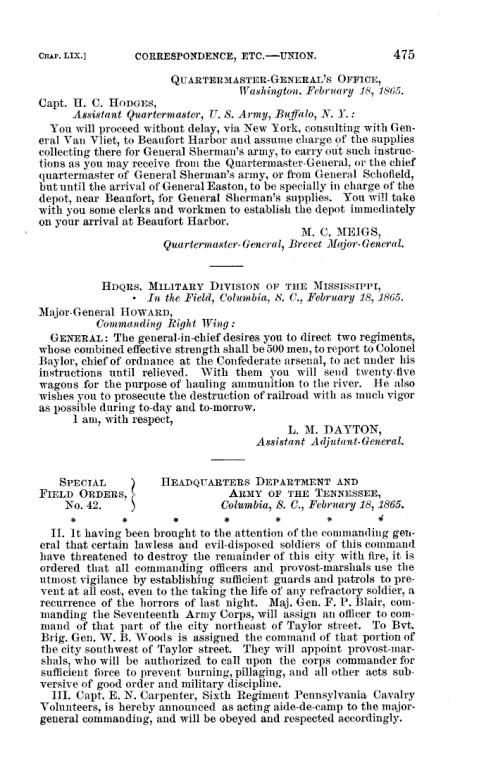
Official Records of the War of the Rebellion. Series 1, vol. 47 (Part 22) P. 475. The “bonkers” message appears at the top of the page.
Stager, Stafford G. Lynch, and other cipher men used this message as a guinea pig for testing various routing instructions being developed for a new cipher. What they were working on was Cipher No. 4, the last cipher to be used during the war. Its predecessor, known as No. 3, was devised by Samuel H. Beckwith in winter of 1864 and included a new set of arbitraries which, among other things, addressed the problem of a “stuck” sounder by avoiding certain letters. (A stuck sounder often resulted in making dashes instead of dots and which, on one memorable occasion turned “pacific” into “fairfye.”) Beckwith’s cipher was unveiled on December 25, 1864 but, for some reason, saw little use.
The top message, first addressed to Stafford G. Lynch, was instead sent to Stager, with the instructions to return it “by train of or in Some confidential manner.” Two different ciphers of the same message were also sent to John Horner in New York.
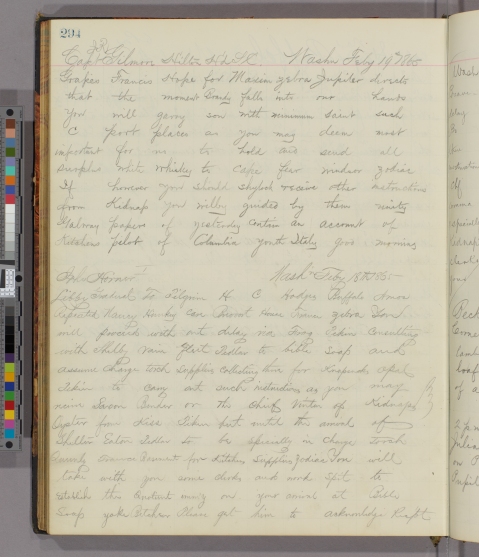
EC 19. Ciphers Sent. 1864, Jan. 27 — 1864, Dec. 2. P. 294. Note a different version of the “bonkers” message, the second on the page.
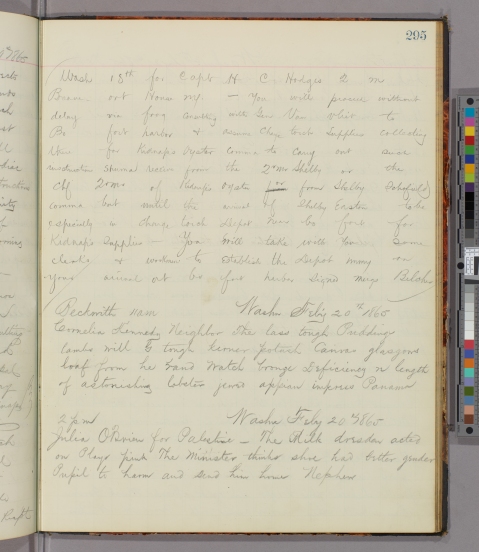
EC 19. Ciphers Sent. 1864, Jan. 27 — 1864, Dec. 2. P. 295. Another version of the “bonkers” message, on the top of this page.
The result of this work was sent to the operators at Grant’s, Sherman’s, and Thomas’s commands on March 23, 1865. The final product, known as Cipher No. 4, numbered some 1608 arbitraries; the key proper comprised 12 pages, each differing in the words used and the route employed. Significantly, the book contained no directions for the use of the cipher; if captured, it was of little use to the anyone who was not a USMT cipher man, including, I am afraid, archivists.
There is one additional takeaway from the story of the “bonkers” message: the fact a message appears in OR certainly does not diminish its historical value.
Olga Tsapina, Norris Foundation Curator of American History. The Huntington Library.
Decoding the Civil War: Phase 2, Two Work Flows, Your Choice
After a year of hard work by our volunteers on Decoding the Civil War, Phase 1, we are about ready to launch Phase 2, the marking of metadata within specific telegrams. There are two work flows to this task. The first work flow, Code Words, is marking the arbitraries, or code words, for those messages in code. These coded telegrams will then be fed into Phase 3, the final decoding of the telegrams. Having the marked arbitraries should make the process of decoding much faster, possibly aided by computer algorithms.
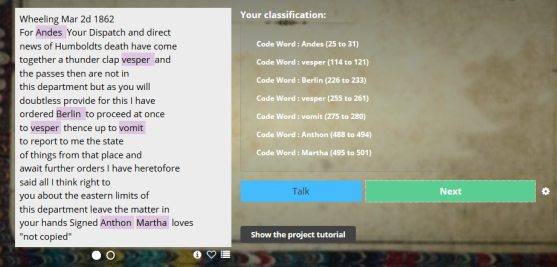
Example of highlighted code words (arbitraries).
The second work flow, Metadata, is a little more ambitious and complex, as we are asking our volunteers to work with individual telegrams, identifying specific metadata such as the sender, recipient, date sent, time received, etc. We are asking for metadata for a total of 10 fields; most telegrams have only a few; rarely do they have all 10. What we wish to accomplish is a way to provide simple metadata that will enable researchers to find all the telegrams to, say, Secretary of War Edwin M. Stanton, no matter whether it is in Ledger 2, or 6, or 22.
But did not Phase 1 enable full-text searching? Yes it did, and it is wonderful, but the transcriptions are accurate to the text as written in the ledger. Keeping with Stanton, if you typed in “Stanton” in the search box, you would get those pages where “Stanton” matches the search. But what if the telegram begins or ends with “EMS” or “Stantin” or “the Secretary of War”? The full-text search would ignore those pages. Furthermore, such a search looks at the whole message and returns results for any mention of “Stanton,” including other people named Stanton or places named Stanton. What if you want to look for Stanton only as the recipient? A search in a specific metadata field for “recipient” would enable that search and give you the correct results.

Example of highlighted metadata fields.
To aid in that search we will take the metadata tagged by the volunteers in Phase 2 and standardize the terms. So, continuing with Stanton, if the recipient is “EMS” and it is tagged as a sender or recipient, we will be able to take the consensus term and edit it to the standardized form of “Stanton, Edwin M. (Edwin McMasters), 1814-1869.” Once all the telegrams are tagged and the fields edited, if you do a specific search for “Recipient” as “Stanton, Edwin M. (Edwin McMasters), 1814-1869.” you will only get those telegrams to Stanton, not from or about him, and you will have those whether they are sent to him as “EMS,” “Stanton,” or “Stantin.”
The tagging of individual telegrams in the Phase 2 Metadata workflow will eventually enable specific searches to be done across the almost 16,000 telegrams. It will enable users to look for individuals or places or dates in specific fields. And the tagging of code words (arbitraries) in the Code Word work flow will help round out this project with the final decoding of encoded telegrams. An incredibly useful archive has been made available in Phase 1 of Decoding the Civil War. Help us leverage and categorize that hard-earned knowledge in Phase 2 to aid in the discovery of the American Civil War.
The Beta Test site for Phase 2 is here. The original site can be seen here.
What Lies Beneath

Sometimes you cannot just help but marvel at what may lie beneath a page filled with seemingly unrelated messages. The only thing these three telegrams have in common is the fact that they were transmitted on the same day, October 15, 1864, and by the same USMT operator.
In the first telegram, Henry W. Halleck (Borgia) instructs Samuel B. Lawrence, the assistant adjutant general to Lew Wallace, (he of the Ben Hur fame), to send the “dismounted cavalry to cavalry Depot.” This would be the Giesboro Point Cavalry Depot, one of the six such facilities maintained by the Cavalry Bureau of the United States Army. It was, in fact, the largest facility of this kind in the world.

Giesboro Point. Andrew J. Russell. 1864. Library of Congress.
The depot occupied the site of a tobacco plantation that belonged to George Washington Young, one of the District’s largest slaveholders. In July 1863, he offered to sell his plantation to the government for $100,000, but the United States army ended up renting the property for $6000 a year. This was not the first time Young received money from the United States government: under the terms of the District of Columbia Compensated Emancipation Act passed by Congress on April 16, 1862, Young had received $17,771.85 for his slaves.
If Young’s property had been located in Maryland, just outside the District, he could have carried on with his plantation. Congress had no authority to abolish slavery in the states. Lincoln tried to get the slaveholding states of the Union to abolish slavery on their own since the fall of 1861. It went nowhere. Maryland was a particularly tough case, as the state constitution explicitly banned “any law abolishing the relation of master or slave.”
In 1864, a predominantly Republican legislature succeeded in calling for a convention that would amend the state constitution. On September 6, the constitutional convention published the new charter which explicitly abolished slavery, and the governor called for a special ratification vote scheduled on October 12 and 13.
The supporters of the new constitution faced an uphill battle. The new constitution drew a firestorm of criticism from Democrats and even moderate Republicans. The critics blasted the document as a flagrant abuse of power that unlawfully deprived Maryland citizens of their “property” in slaves. The critics also singled out the provisions that mandated loyalty oath as a condition of casting the ballot and allowed soldiers in the field to vote.
On October 15, the returns were still being tallied and things did not look good. On 11:20 a.m., the USMT operators received a message from Henry W. Hoffman (1825-1895), a staunch Lincoln supporter who had canvassed the state in support of the constitution. according to Hoffman, “on the home vote” the constitution was likely to be defeated by a “probable maj[ority]” of “about one thousand.” There might be some good news, as it “is believed that the soldiers vote may overcome this & give a small majority for the Constitution.”

Henry H. Hoffman. Telegram to Abraham Lincoln. Oct. 15, 1864. Library of Congress
Lincoln replied with the second telegram on this page: “Come over to-night and c (see) me.” Lincoln must have realized that Hoffman was indeed correct. The constitution was in fact defeated by 1995 votes. Only after the soldiers’ ballots were counted, Maryland abolished slavery by a whopping 375 votes.

Three hours later, the operator tapped out the third message. Deciphered, it reads: “8 p.m. for C.A. Seward 29 Nassau St. William T. Minor Consul General and Thomas Savage Vice-Consul General Havana. William Hunter Chief Clerk State Department and G.G Tassara Spanish minister Washington. See Mr. Evarts ask to cooper rate [cooperate] with you. Signed F.W. Seward.”
The sender was Frederick W. Seward, the son of the Secretary of State and an assistant secretary of state in charge of consular service. The addressee was his cousin, Clarence. A. Seward, partner in the prominent law firm Blatchford, Seward & Griswold. “Mr. Evarts” was William Maxwell Evarts (1818-1901), partner in the renowned New York law firm Butler, Evarts, & Choate.

Frederick W. Seward.
Why would an assistant secretary of state use the military telegraph to get his cousin in touch with the Spanish ambassador, the U.S. consular service in Havana, and another lawyer?
Both Clarence A. Seward and Evarts had been involved in high-profile of José Agustín Arguelles, lieutenant governor of the district of Colón, Matanzas, who was arrested in New York on charges of engaging in slave trade. The arrest was made upon a request of Cuban officials and the Spanish ambassador Gabriel Garcia y Tassara, and Arguelles was extradited to Cuba, despite the fact that the United States did not have an extradition treaty with Spain.
The arrest and rendition had caused a loud scandal. Arguelles’ wife filed a writ of habeas corpus with a New York court. Seward was accused of authorizing an unlawful arrest and violating Arguelles’ right of the asylum. The Secretary of State refused to back down: when called to testify before Congress, he declared that the United States, “the refuge of the innocent and oppressed,” could not, in good conscience, offer asylum to a slave trader, “the guilty betrayer of human freedom.”
In the meantime, a warrant was put out for the arrest of Robert Murray, the U.S. Marshal who had arrested Arguelles. It was Clarence A. Seward and William M. Evarts who represented the hapless marshal against the charges of kidnapping. The case was dropped in June 1864, do doubt due to their expert ministrations.
This telegram seems to indicate four months later both lawyers were still working with the State Department. It is likely that this cooperation had something to do with the fact that in 1865 a Cuban court found Arguelles guilty of slave trading and sentenced him to nineteen years of hard labor.
That a pedestrian looking page turns out to be teeming with soldiers, diplomats, lawyers, politicians, and even horses attests to the allure of archival work. We are, after all, dealing with a special kind of magic that somehow condenses entire lives, stories, and dilemmas into a single page jotted down some hundred and fifty years ago. And is it a mere a coincidence that all telegrams found on this randomly (I swear!) selected page should somehow have something to do with slavery?
Laughing Matter
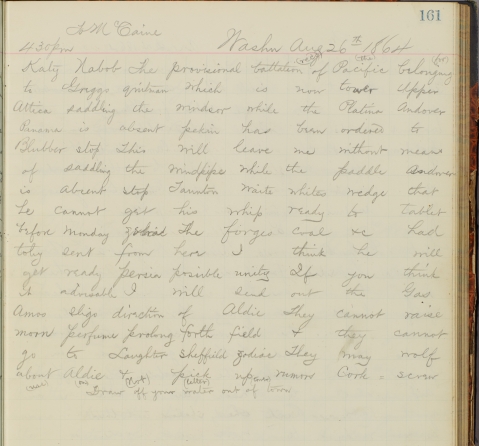
To McCaine
4:30 pm Washn. Aug. 26th 1864
Katy Nabob The provisional battalion of Pacific belonging
to Greggs quitman which is tower upper
Attica saddling the Windsor while the Platina Andover
Panama is absent pekin has been ordered to
Blubber stop This will leave me without means
of saddling the windpipe while the paddle Andover
is absent stop Taunton Waite whites wedge that
he cannot get his whip ready to Talbot
before Monday zebra The forges coal &c had
toby sent from here I think he will
get ready Persia possible unity If you think
it advisable I will send out the Gas
Amos sligo direction of Aldie They cannot raise
more perfume prolong forth field & they cannot
go to Laughter Sheffield zodiac they may wolf
about Aldie & pick up rumors Cork = screw
Draw off your water out of town
Decoded, reads:
To McCaine
4:30 pm Washn. Aug. 26th 1864
4:30 P.M. P. H. Sheridan The provisional battalion of Cavalry belonging
to Greggs Division which is over the upper
Potomac guarding the River while the 8 Illinois
Calvary is absent comma has been ordered to
City Point stop This will leave me without means
of guarding the River while the 8 Illinois
is absent stop Major Waite reports today that
he cannot get his Regiment ready to movement
before Monday period The forges coal &c had
to be sent from here I think he will
get ready as soon as possible period If you think
it advisable I will send out the 16
New York in the direction of Aldie They cannot raise
more 3 hundred for the field & they cannot
go to Snicker Gap period they may scout
about Aldie & pick up rumors Augur
Draw off your water out of town
On August 26, General Christopher Columbus Augur, the commander of the the defenses of Washington, D.C., sent a ciphered telegram to Phillip Sheridan who was in the process of planning an expedition against John S. Mosby’s men. Major John M. Waite of the 8th Illinois Infantry was charged with leading the force. He, however, needed some time to assemble the men: the regiment, formally part of Augur’s XXII Corps, had been scattered on all over Virginia and Maryland: six companies were assigned to Lew Wallace at Baltimore, four were guarding the Potomac between Great Falls and the Monocacy, another was at Port Tobacco, and one was with the army of the Potomac. Augur, still reeling from Jubal Early’s raid on Washington on July 11, was not overly enthusiastic about the arrangement. The best he could to reinforce the expedition was the 16th New York which had already been cut up by Mosby’s men.
As with many telegraphic communications between generals, this telegram was published in the Official Records of the War of the Rebellion, after the deciphered recipient’s copy. 
Our telegram, which appears in the USMT ledger of sent messages (EC 18), is not just the ciphered version of the OR publication. For one thing, it was sent from the USMT office at the War Department an hour and a half after the original message went out from the headquarters of the XXII Corps, located on the corner of Fifteenth and a Half St. and Pennsylvania Avenue. The message is addressed to R.R.R. McCaine, Sheridan’s operator, rather than Little Phil himself.
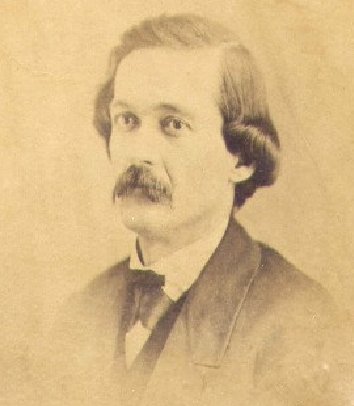
Robert Rezin Redman McCaine, 1833-1873
And then there is the strange appendix involving a cork screw and instructions to “draw your water out of town.” In fact, the message offers a glimpse into how codes were modified and adjusted, which often happened on the fly.
The message had been ciphered a variation of Cipher No 1. This version, found in EC42, EC44, and EC46, features significant and apparently recent changes. The term “commencement word” was replaced with “blind word” which indicated the number of columns rather than lines. 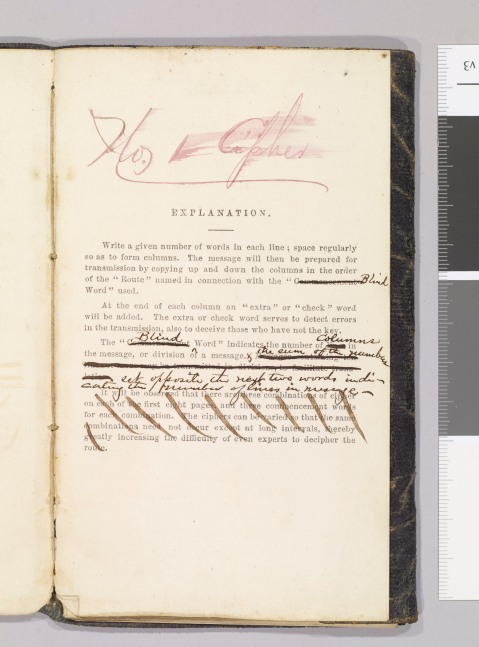
As seen from the handwritten corrections made in EC 46, “the sum of the numbers set the opposite the next two words” indicated the number of lines. “Town” equaled to 6 lines, and “water,” to 10, which translates into sixteen lines of the eight-column message.
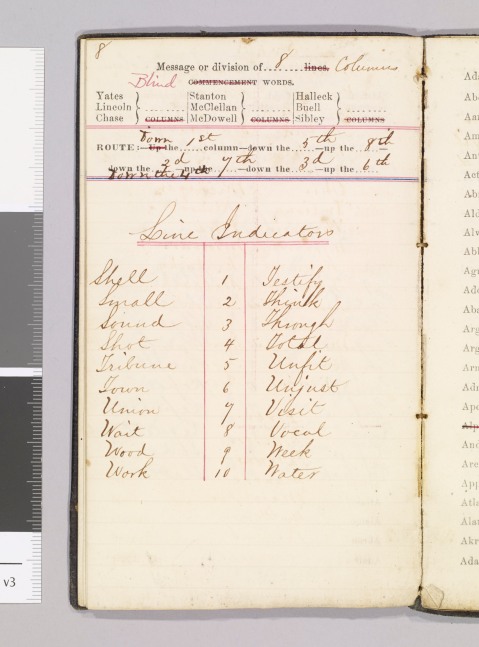
Instead of simply instructing McCaine to add the values, however, his Washington counterpart opted by a coded message involving the “cork-screw” and drawing off, i.e. “decanting,” his “water out of town,” and added a few words at the top and bottom of the message. When the operator followed the respective routing instructions, he saw a tip to “use tower for on the Not Received letter.” (The value of the arbitrary “tower” as listed in the code book is “over the.”) Most likely, this message was not even intended for Sheridan’s eyes, but rather served as a test case for changes and modifications in ciphers.
It should be noted that the term “Cork=screw” is a triple play on words. The message was sent by Augur, a homophone of which is “auger”. An auger is a helical screw, often used for boring holes in things. A short step sideways and you have “corkscrew,” split in two to fit the columns. (Thank you MEinaudi for this find. I must confess, my knowledge of drilling equipment and terminology a bit limited; I was thinking more along the lines of an augur as in the ancient Roman priest. This, of course, would be very hard to code).
And another thing. Because there was no arbitrary for Snickers Gap, Va., the operator had to improvise: Snickers was replaced, of course, with “Laughter.” I would probably go with “Chortle” or “Giggles.”
Finders Keepers
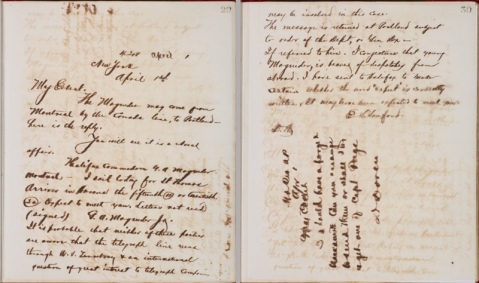
4:20 P April 1
New York
April 1st
Maj. Eckert.
The Magruder msg come from
Montreal by the Canada line, to Portland –
here is the reply.
You will see it is a Naval
affair.
Halifax Commodore G.A. Magruder
Montreal – I sail today for St. Thomas
arrives in Havana the fifteenth (15) or twentieth
(20) Expect to meet you. Letters not recd
(signed) G.A. Magruder Jr.
It is probable that neither of these parties
are aware that the telegraph line runs
through W.U. Territory & an international
question of great interest to telegraph companies
may be involved in this case.
The message is retained at Portland subject
to order of the Dept, or Gen Dix.
If referred to him. I Conjecture that young
Magruder is bearer of dispatches from
abroad. I have sent to Halifax to make
certain whether the word “expect” is correctly
written, It may have been expected to meet you.
E.S. Sanford
D.H.
What do you do when an enemy communication just falls into your lap?
On March 31, 1864, a puzzled Edward S. Sanford sent a message from the New York office of the American Telegraph Company. The Company’s office in Portland, Maine had received a telegram addressed to “Maj. G.A. Magruder at Halifax.” The sender was Commodore George Allan Magruder (1800-1871), the former chief of the U.S. Bureau of Ordnance and Hydrography of the Navy Department who lived in Montreal ever since he resigned from the service in April 1861. The recipient was his son and namesake, Major George Allan Magruder, Jr., (b. 1842), a Confederate officer on the staff of his uncle, John Bankhead Magruder. Since October 1863, the younger Magruder acted as a special envoy of the Confederate State Department and carried diplomatic dispatches to Europe and Cuba.
How did a message sent from Montreal to Halifax end up in Portland? Sanford thought “it was not sent by Magruder in person but brought to Portland by some one [who] had orders to forward from first telegraph station.” This theory fell through the next day, when the Maine operator received the response. Magruder informed his father that he was about to sail for St. Thomas, to arrive in Havana in two to three weeks, adding that he had received no letters.
Sanford shouldn’t have been so puzzled. Right before the war, his own company, the American Telegraph Company had engineered a long-term lease of two major Canadian companies, the New Brunswick and Nova Scotia Electric Telegraph lines, thus linking Nova Scotia and Maine. Apparently, the Magruders used the Nova Scotia company unaware that it was operated by Sanford’s outfit.
The messages were not intercepted. Neither the USMT nor Sanford, who was serving as “military supervisor of telegraphic messages,” had anything to do with obtaining this piece of intelligence. It’s just sort of wandered into an office of a private commercial telegraph line.
The realities of the Civil War often run contrary to our ideas of what war-time communication lines are supposed to be. There was, of course, no unified system of military telegraph. In February 1862, Congress had authorized President Lincoln to “take possession of any or all the telegraph lines in the United States, their offices and appurtenances.” The Lincoln administration did no such thing. Instead, the War Department created what historian Joshua D. Wolff called “a mixed military economy” which relied on private contractors and “public enterprises.” (Western Union and the Creation of the American Corporate Order, 1845-1893 (Cambridge University Press, 2013).
The system created numerous problems. The USMT leadership retained their positions of executives of communications companies, raising suspicions about a conflict of interest. The leadership of Western Union and the American Telegraph Company painted themselves as selfless patriots. The reality was more complicated: serving as government officials while overseeing their own businesses, the companies’ managers not only turned the United States government into their customer, but also harnessed the military necessity to extract the unprecedented level of protection, public funding, and material support.
The overlapping commitments more or less erased the boundaries between public service and private interest. For example, Stanton’s directives that military supervisors did not interfere with “private business” could jeopardize military secrecy, as with no provisions for an eventuality of said business located in a border or even a Confederate state.
As it turned out, it was also possible that an American commercial company could transmit messages sent and received abroad. No wonder Sanford was stumped. There was neither precedent nor proper chain of command. Eckert was to contact Charles A. Dana, newly appointed Assistant Secretary of War, to find out “to whom we can refer similar cases when they require alert action.”
There were also international implications to think about. Was it legal for a party in a civil war to intercept messages originating in another sovereign nation, especially if such intercept was done by a private company? With some relief, Sanford remarked that because it was “probable that neither of these parties are aware that the telegraph line runs through W.U. [Western Union] Territory,” an “international question of great interest to telegraph companies may be invalid in this case.” (Western Union did not have any holdings in Canada). In other words, finders keepers.
Hurrah for our volunteer JustStardust for spotting this!
Olga Tsapina, Norris Foundation Curator of American History. The Huntington Library.
“Honest Old Abraham”
Olga Tsapina, Norris Foundation Curator of American History, Huntington Library.
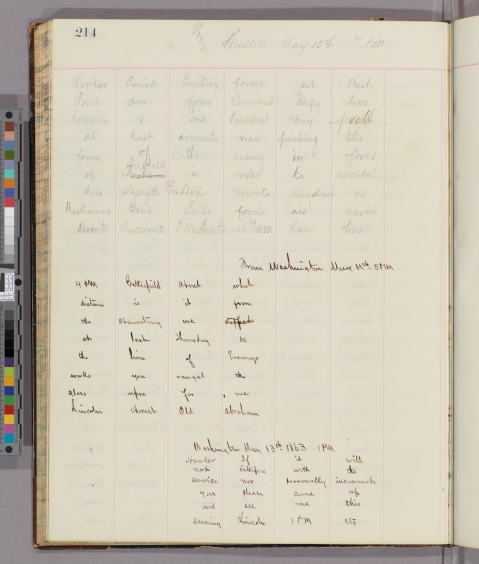
From Washington May 11th 5 P.M.
4 PM. Butterfield About what
distance is it from
from the Observatory, we stopped
at last Thursday to
to the line of Enemys
you ranged the glass upon for me
Lincoln Honest Old Abraham
Quite a few telegrams in the Eckert ledgers have little messages from operators that filled up empty spaces at the end of the last line. Most of these notes are greetings of various degrees of jocularity (“wake up Charles!”), brief remarks about the ever so popular subject of the weather (“hot here” in the telegram on this page), reports of incidents (“Lawrence lost his cap”), observations the fighting, which often read like weather reports, or market tips. This telegram ends with a breathless tribute to Lincoln.
The telegram is part of the ledger EC 23 which comprises messages, mostly in cipher, sent from the War Department to the Headquarters of the Army of the Potomac and Fortress Monroe during the disastrous battle of Chancellorsville (1863, Apr. 30 – May 6), and its immediate aftermath.
The disaster was in large part caused by a breakdown in communications. Hooker’s battle plan hinged on complex system on the telegraph and flag signaling, which, ideally, would provide him with an unprecedented mode of instant communication. The USMT operators were to handle strategic communications between the army and Washington. The Signal Corps was charged with tactical communications between the army’s wings and units provided by the traditional flag signaling system and new Beardslee Patent Magneto-Electric Field Telegraph machines. Hooker’s chief of staff, Daniel Butterfield, was charged with overseeing all the communications.

Daniel Butterfield. Ca. 1860-1865. Courtesy of the Library of Congress https://www.loc.gov/item/cwp2003000293/PP/
The plan fell apart almost immediately. Beardslee machines were easily “disarranged,” which resulted in hours-long delays and messages garbled beyond recognition.

Beardslee Patent Magneto-Electric Field Telegraph machine. http://www.beardsleetelegraph.org/
For some eighteen hours, the right wing of Hooker’s army was plunged into a communications blackout. On May 1, Butterfield dispatched USMT operators to take over. By then it was too late.
All the while the president and the War Department were kept in the dark. Hooker had instructed Butterfield not to wire anything to Washington. It was only at 8:50 a.m. on May 3 when Butterfield informed Lincoln that “a battle is in progress.” By then Washington was already awash in increasingly panicky rumors. At 1 p.m. on May 4, Butterfield wired that the army re-crossed the Rappahanock. Two hours later, Lincoln telegraphed “We have news that that the enemy has reoccupied heights above Fredericksburg is that so?” Hooker conceded: “I am informed that is so, but attach no importance to it.” On May 6, 1863, Hooker ordered the remaining troops to re-cross the north side of the Rappahanock. It was over. Lincoln received the word at 3 p.m. An hour later, Lincoln and Halleck boarded a steamer for the Army of the Potomac.
The president spent Thursday, May 7, at Hooker’s headquarters. At the end of the day, Lincoln refused to blame anyone and expressed his full confidence in the general. The War Department decided to put a positive spin on the defeat: not only “there “has been no serious disaster to the organization or the efficiency of the army,” but thanks to the “brilliant success” of Stoneman’s raid on Richmond, the enemy’s communications “have been cut in all directions.” This was an exaggeration, to say the least. The railroads that Stoneman claimed to have destroyed were fully operational by May 8. Hooker later grumbled: “I might as well have had a wet shirt command my cavalry,” adding: “ Had Gen. Lee’s communications with Richmond been severed, not many of his Army would ever have returned to that city.”
A disruption in the enemy of communications did occur, however. During the battle, the wig-wag signaling played an important role, although not the one intended. When it became apparent that the Confederate signal officers could easily read the Union signals, Butterfield ordered not to use them only to transmit false information.
As seen from this telegram, Butterfield took Lincoln on a tour of the lines of signal-flag stations. The” Observatory” is most likely the central station, known as Station F., located halfway between Falmouth and the Army of the Potomac headquarters. A notorious self-promoter and a loyal ally of Hooker’s, Butterfield, no doubt, worked hard to impress the president with the importance of flag-signals. Four days later, Lincoln was still thinking about how close the enemy lines were. Butterfield helpfully supplied that the distance between the lines was just “about two miles in a direct line.” As we have already seen, in the coming months, Butterfield regularly forwarded intercepted signals to the president. (See The Dust of War https://blog.decodingthecivilwar.org/2017/06/19/the-dust-of-war/)
But why would an USMT operator feel so overwhelmed by this seemingly routine message? Lincoln certainly was no stranger to the USMT office. The president spent hours at the cipher room, (he usually commandeered Eckert’s desk), drafting numerous telegrams and handing them over to the operators.
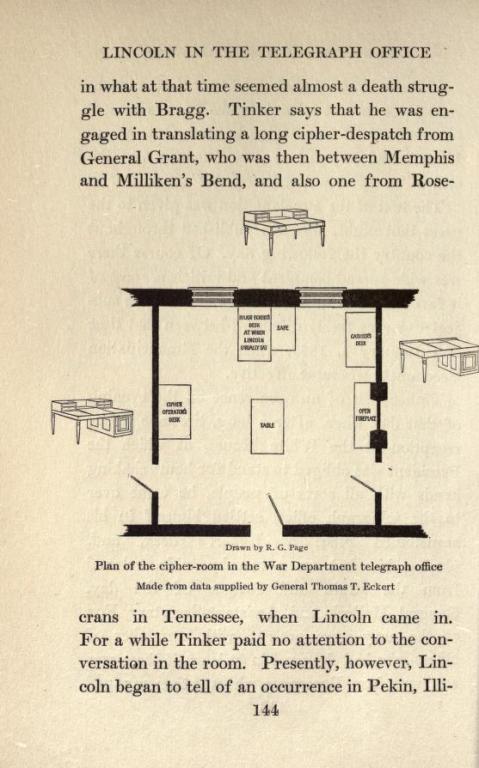
“Major Eckert’s desk at which Lincoln usually sat” (David Homer Bates, Lincoln at the Telegraph Office recollections of the United States Military Telegraph Corps during the Civil War (1907).
Curiously, there is no handwritten draft of this message. The draft of the telegram to John A. Dix, sent just before the message to Butterfield, has been preserved and now forms part of the Charles W. McClellan Lincolniana collection at the Brown University. Neither does it appear in the Official Records of the Rebellion, unlike the telegram to Hooker on the bottom of this page.
The editors of the Collected Works of Abraham Lincoln published it after the text in the 1865 Report of the Joint Committee on the Conduct of the War. The Committee was then investigating the Army of the Potomac; the heavily politicized inquiry aimed at replacing George G. Meade with Joseph Hooker and necessarily sought to rewrite the history of the battle of Chancellorsville. The telegram was among a batch of records covering Hooker’s command of the Army of the Potomac assembled by Edwin M. Stanton.
It is possible that Lincoln’s draft was lost, misplaced, misfiled or even destroyed by the clerks who prepared the Joint Committee’s final report. It is also, however, possible, that no draft ever existed and that the telegram was dictated rather than written. This would explain the operators’ gushing note: he was obviously thrilled to transmit “Honest Old Abraham’s” own words as the great man loomed over his desk.
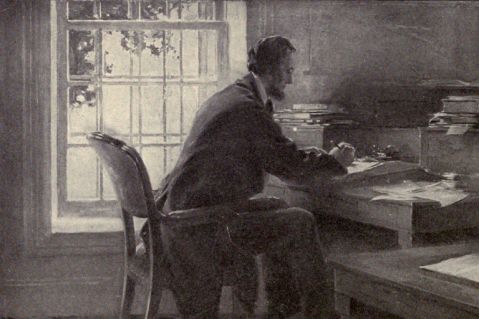
Frontispiece. David Homer Bates, Lincoln at the Telegraph Office recollections of the United States Military Telegraph Corps during the Civil War (1907)





